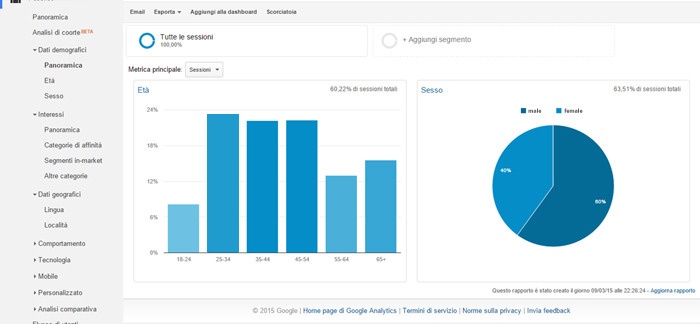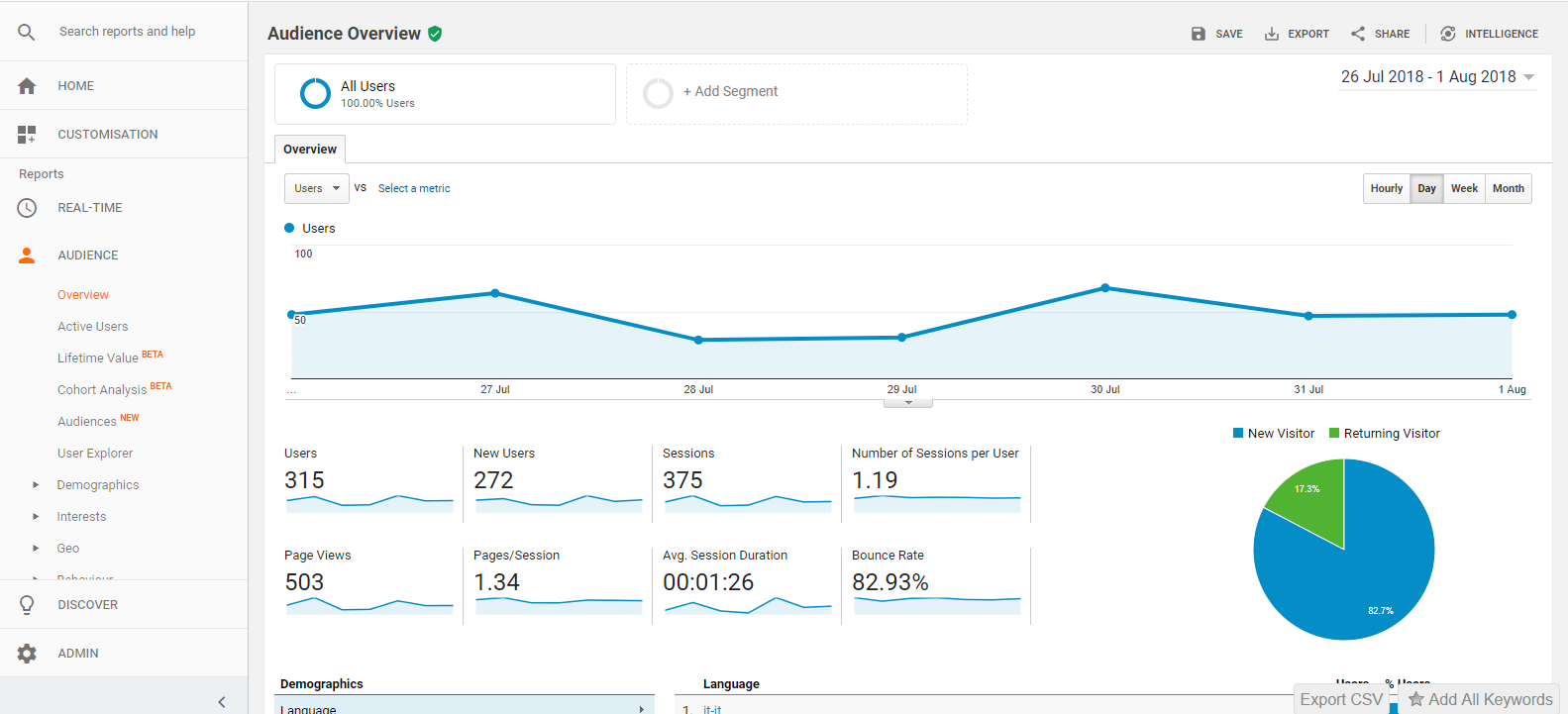A prospective buyer is the semi-fictitious representation of your client-type and is built by collecting and analyzing your real clients’ data. An excellent tool for studying your prospective buyer is Google Analytics. In the following article, we’ll look at the principle features of this tool and how fundamental it is in order to study your ideal client.
Hereunder, the points we’ll discuss in the article:
- Why you need to know your prospective buyer;
- How to use Google Analytics to obtain the data you need;
- How to create a prospective buyer using data from Google Analytics;
- How to create a strategy according to your prospective buyer.
Why you need to know your prospective buyer
Recognizing your prospective buyer is fundamental for improving your marketing strategy, understanding what your clients truly need, creating useful forms of content in every stage of the funnel, all to generate dialogues.
Google Analytics provides you with vital data on your real clients, thanks to which you can study and achieve your prospective buyer.
Many consider collecting and analyzing data to be quite a boring task. Nothing could be more wrong! It’s one of the most gripping stages, that of understanding and exploring. The moment you come into contact with people who show interest towards your company, when they visit your website, download a brochure, sign up to your newsletter and make a purchase in your e-commerce section.
This is why studying a prospective buyer is something that can’t be left to chance or given over to one’s intuition. On the contrary, it has to be structured across a careful analysis of data supplied by tools like Google Analytics.
You can collect the following data, thanks to Google Analytics:
- Demographics;
- Interests;
- Sources of traffic;
- Geolocation of visitors;
- Use of website by users.
“If it doesn’t come from a buyer’s mouth it’s a guesswork. Are you betting your job on a guess?
How to use Google Analytics to obtain the data you need
Google Analytics provided you with four areas through which you truly have the chance to understand who your clients are and how they interact with your site: audience, acquisition, behavior and conversion.
Audience
In this area you can analyze the following report: demographics, interests, geographic data and mobile device.
Demographics
You can reveal two fundamental pieces of information in this area: the age of your clients and their gender. Reports can be generated based on one aspect, like the age bracket, for instance, to understand which generates the largest volume of traffic, but also which one provokes the highest rate of conversion.

Reports can also be created according to a combination of both, such as age bracket and gender, to see results based on rate of conversion.
Interests
Another important element of this area is the “interests” voice that allows you to delve even deeper into categorizing your prospective buyer.
This voice corresponds to the following reports A tale voce corrispondono i seguenti report:
- Affinity category: the users are defined through their interests (technophiles, sports fans, tv-lovers, foodies, etc.);
- In-market segments: the users are identified according to their purchasing interests;
- Other categories: these specify our clients’ interests, listed in a generic way in the “affinity category” voice.
Geographic Data
- Language;
- Locality.
The data that correspond to this voice, language and locality, help you to undertsand, in detail, where your vistors are coming from and which locality generates the greatest amount of traffic and the highest rates of conversion.
Mobile Device
The “mobile device” voice is corresponded by data related to the way visitors connect to your website, whether it’s through desktop, mobile, tablet. For instance, reports can be generated that enable you to understand whether the greatest amount of transactions are made through desktop, mobile or tablet.
Acquisition
In this are you can select which channels are most used by your users to connect to your website:
- Source/half;
- Adwords;
- Console-Query Search;
- Social.
The reports related to channels allow you to evaluate which ones generate the highest volume of traffic and to compare this data with the rate of conversions. It’s not necessarily the case that the great volume of traffic generated from a specific channel then leads to a higher number of purchases. Google Analytics’ analysis of data enable you to determine what your users’ behavior is like and understand which aspects of your site’s performance require improvements.

Behaviour
The following reports are available in the Behavior-area:
- Behavior-flow of people visiting your website;
- Contents of the site (for every piece of content we can see the average session-duration, the rebound-frequency);
- Speed of website;
- Research related to the site.
In this way it’s possible to understand which contents capture your users the most, but also which ones present fiction in the process of navigating the site; how rapidly the pages load and what kind of research gets users onto the site.
Conversion
In the conversion-stage, we can measure:
- the reaching of objectives;
- the users’ behavior on your site;
- the way in which users purchase on the site;
There are three sections within the conversion-area that provide us with access to this kind of monitoring: objectives, e-commerce and multi-channel canalization.
Objectives
- Destination (for example, the thank you page after filling out a form);
- Duration (monitoring visits);
- Involvement (measuring sessions with a certain number of visited pages);
- Events (eg. Clicking on the play-button of a video).
E-Commerce
- Monitorization of sales-yield;
- Report on the purchasing behavior, from the intial stage to the final transaction.
Multi-channel Canalization
- The route taken by users across various marketing channels that takes them from initial interest to conversion;
- The amount of time between the intial interest and final conversion;
- Attributing a particular conversion to a specific channel.
More often than not, a user doesn’t follow the linear route of “research-website-purchase”. His/her customer journey can begin with a search engine, inserting key words, then continue on the site, to then exit it and return after seeing a sponsored ad on Facebook.
In this case, we find ourselves looking at quite a discontinuous route and the data from Google analytics help u sto under stand what the various touch-points are, how much time has passed between initial interest to purchase and, in doing so, which channel is the best for generating conversions.

Creating your prospective buyer using data from Google Analytics
Let us, for example, suppose you have a school that provides courses for cake design. Let’s assume that you gathered the following demographic reports from Google Analytics:
- the percentage of female users is greater than that of males;
- the age bracket between 25 and 35 generates the highest volume of traffic and a high rate of conversion;
- your users’ main interests are cuisine and cake design;
- the largest number of conversions comes from desktops;
- the densest volume of traffic is generated from Italy, specifically Naples.
By analyzing the reports of the acquisition-section, you collected the following data on your website, that is, the channels that generate the greatest traffic are:
- Social networks;
- Adwords;
- Organic traffic;
- Web-search.

You were able to verify the following data from analyzing the behavior of users on your site:
- Pages from the blog related to decorating cupcakes and tutorials are the ones that generate the largest amount of macro-conversions, (the users fill out the registration form for the newsletter or book the course after visiting these pages), but also micro-conversions, (users click on the play button of the video tutorial).
Based on this data, you can begin to structure your prospective buyer:
- Name: Anna;
- Age: 33;
- Female;
- Neopolitan;
- Interests: Cuisine/cake design/cupcake decorations;
- Connects via desktop;
- Uses social media to find information;
- She’s interested in the course, especially because she wants to learn to decorate cupcakes.
Creating a strategy based on your Prospective Buyer

Your prospective buyer, although not totally completed, because it only refers to the data collected on Google Analytics, still provides you with useful insights to then be able to form a strategy of effective contents:
- focusing on social media campaigns and on sharing via constant updates of quality content;
- improving the SEO optimization in order to generate a greater flow of traffic, even directly from the search engine;
- identify which pages of your site and blog generate little interest and implement contents. Sometimes the reasons for abandonment don’t exclusively depend on the type of content, but also on the usability or loading speed of the page;
- implement contents using video tutorial;
In the awareness stage, it’s important that your company be present where your prospective buyer is carrying out his/her search. In the case of the prospective buyer, Anna will firstly search on social media and therefore it’s important that you man that channel with quality contents that generate traffic towards your website.
In the consideration stage, Anna will need to know that your cake design course suits her and thus it’s important that your site pages supply the information she needs, even through free content, (see tutorials for cupcake decorations), that increases her sense of faith in your company and leads her to purchase.
In this case, we can speculate on quite a linear route to simplify things, but in reality, like we saw with “multi-channel canalization”, it isn’t; the route a user takes before arriving at the conversion stage is quite erratic. The user can can begin via a search engine, then continue by navigating the site, then abandon it and return after seeing a sponsored ad on Facebook.
It’s therefore good to consider all the touching points along the customer journey in order to man them in an effective way.
Conclusion
Now that you’ve understood how fascinating it is to study your clients, understand what they need and how useful it is for your marketing strategy, you won’t be able to rely on chance or your nose for business to understand them. The prospective buyer is based on your real clients, on their needs and therefore it’s worth achieving this figure through collecting and analyzing structured data, using the right tools.
“If it doesn’t come from a buyer’s mouth it’s a guesswork. Are you betting your job on a guess?”
Adele Revella – BuyerPersona.com
What about you? Have you already defined your prospective buyer?
To start, download our free template to build your first prospective buyer!

